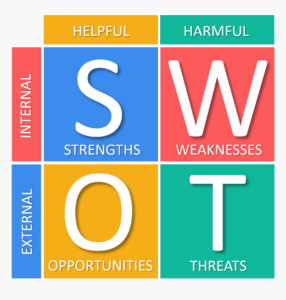SWOT ANALYSIS | The 10 Most Common Benefits Of Conducting A Personal SWOT Analysis
SWOT ANALYSIS. SWOT stands for Strength, Weakness, Opportunity, and Threat. A SWOT analysis guides you to identify your organization’s strengths and weaknesses (S-W), as well as broader opportunities and threats (O-T). SWOT analysis is a strategic planning and strategic management technique used to help a person or organization identify strengths, weaknesses, opportunities, and threats related to business competition or project planning. It is sometimes called situational assessment or situational analysis.
A SWOT analysis can offer helpful perspectives at any stage of an effort.
- You might use it to:
- Explore possibilities for new efforts or solutions to problems.
- Make decisions about the best path for your initiative.
- Identifying your opportunities for success in the context of threats to success can clarify directions and choices.
Determine where change is possible.
- If you are at a juncture or turning point, an inventory of your strengths and weaknesses can reveal priorities as well as possibilities.
- Adjust and refine plans mid-course. A new opportunity might open wider avenues, while a new threat could close a path that once existed.
- SWOT also offers a simple way of communicating about your initiative or program and an excellent way to organize the information you’ve gathered from studies or surveys.
SWOT analysis can help the following people.
- Students
- Managers and Owners
- Professionals, Executives
- Career Starters
- Practitioners and HR
- Doctors and Engineers
- Employees
- Husband and Wife
- Parents
THE ADVANTAGES OF CONDUCTING A PERSONAL SWOT ANALYSIS:
- The main purpose of a SWOT is to promote the identified strengths, reduce weaknesses, exploit the opportunities, and have contingency plans to minimize threats.
- There are many benefits and advantages of using SWOT Analysis for personal development.
- It is good for your success and betterment.
Some of the most common benefits of conducting a personal SWOT analysis have been mentioned below.
- Helps to develop strategies to attain your goals.
- You can be better than your friends and colleagues.
- Shows where you currently stand on the path of success.
- Measures your scopes of reaching desired goals.
- Boosts your career, life, and personality.
- Helps to better understand who you are as a person.
- Maximizes your strengths and diminishes your weaknesses.
- Explores and also enhances your soft skills and hard skills.
- It helps you understand your preferences and personality traits.
- Focuses on your attitudes, abilities, skills, capabilities, and capacities.
USING THE SWOT ANALYSIS TOOL:
Strengths:
- These are the traits or skills that set you apart from others.
Questions to ask include:
- What benefits do you have which others do not have?
- This could include skills, education, or connections.
- What are you better at than anyone else?
- What personal resources do you have access to?
- What do other people see as your strengths?
- Which achievements are you most proud of?
- What values do you believe in that others fail to show?
- Are you part of a network no one else is involved in?
- What connections do you have with powerful people?
Weaknesses:
- This part examines the areas in which you need to improve and the things that will set you back in your career.
Questions to consider include:
- What work do you usually avoid because of a lack of confidence?
- What do people think your weaknesses are?
- Are you happy with your education and skills training?
- Do you have any negative work habits?
- Which of your personality traits hold you back?
Opportunities:
For the opportunities section, look at the external factors you can take advantage of to pursue a promotion, find a new job,b or determine a career direction.
- What new technology can assist you?
- Can you take advantage of the market in its present state?
- Do you have a network of strategic contacts to offer good advice or help you?
- Is any of your competitors failing to do something important? Can you take advantage of it?
- Is there a need in your company which no one is filling?
- Could you create an opportunity by offering solutions to problems?
Threats:
- This part takes into account the external factors that could hurt your chances to attain your goals. The factors to take into account include:
- What hindrances do you currently face at work?
- Is any of your co-workers competing with you for projects or roles?
- Is your job changing?
- Can technological changes threaten your position?
- Could any of your weaknesses lead to threats?
EXAMPLE OF SWOT ANALYSIS:
- SWOT tool used by a small independent book store:
HELPFUL
INTERNAL
STRENGTHS:
- Our workers are well-educated students who love books
- The space is attractive and inviting
- Customers are supportive of the small book store’s popular cafe makes it easy for customers to linger and find something to buy.
HARMFUL
WEAKNESSES:
- Space is tight
- Bank gave us a limited loan
- Business is slower during summer vacation
EXTERNAL
OPPORTUNITIES:
- We can have local authors give lectures and book signings.
- We can make personalized recommendations to long term customers
- We can deliver the same day to mobility-impaired customers
- We can feature things that appeal to summer tourists
- We can start a frequent buyer program
HARMFUL
THREATS:
- Large chains have more buying power
- E-books and e-book readers
- Younger generations don’t read as much
- The nearby public library reopened after two years.




